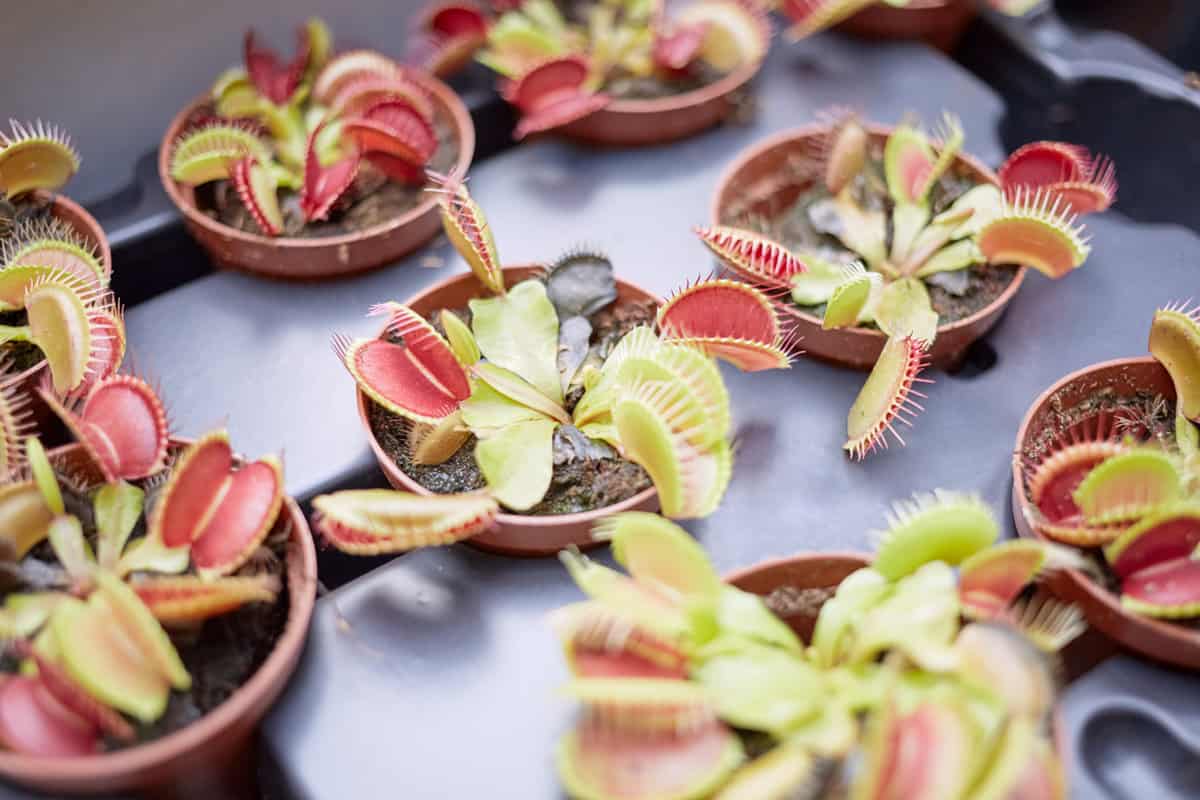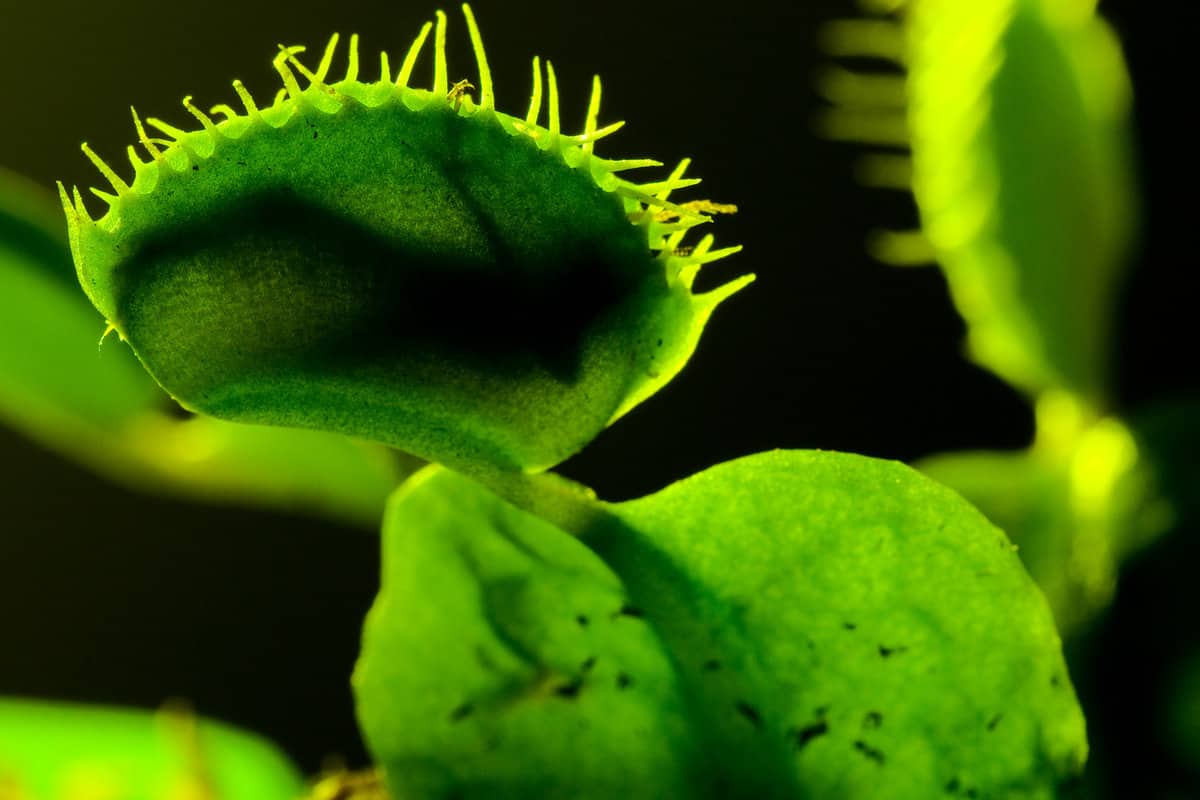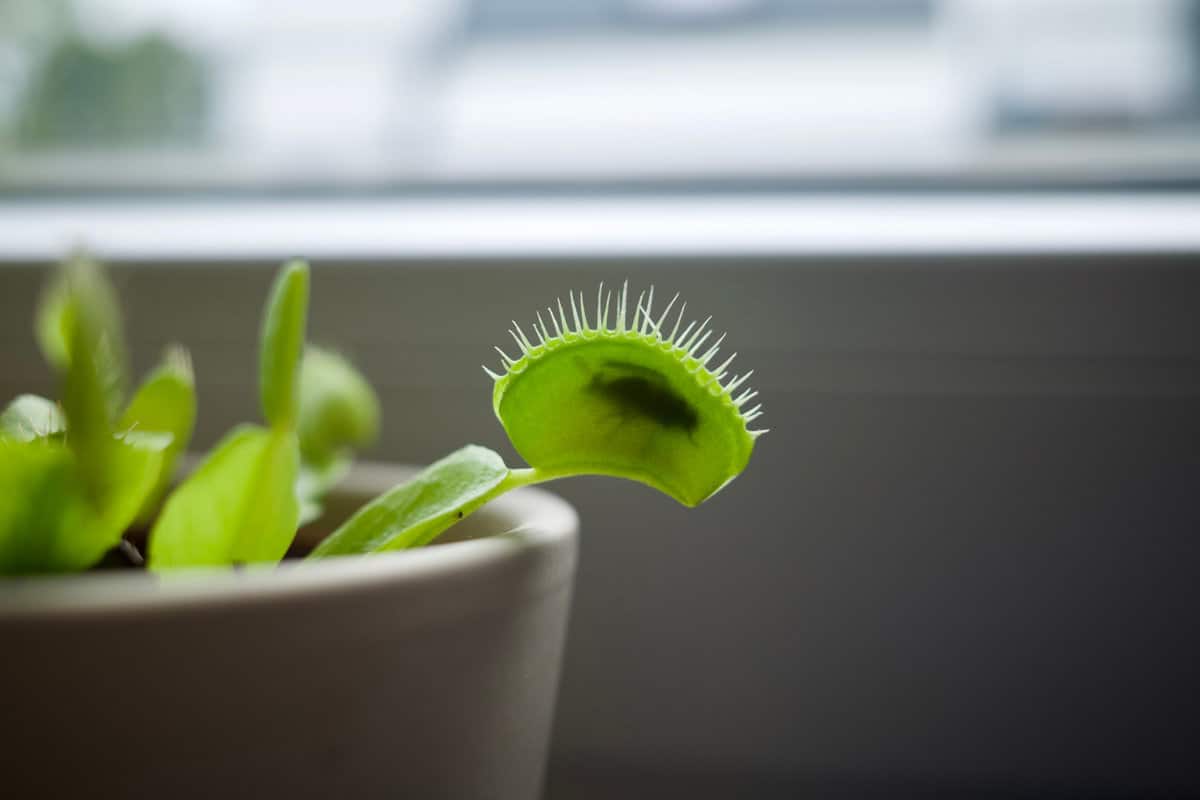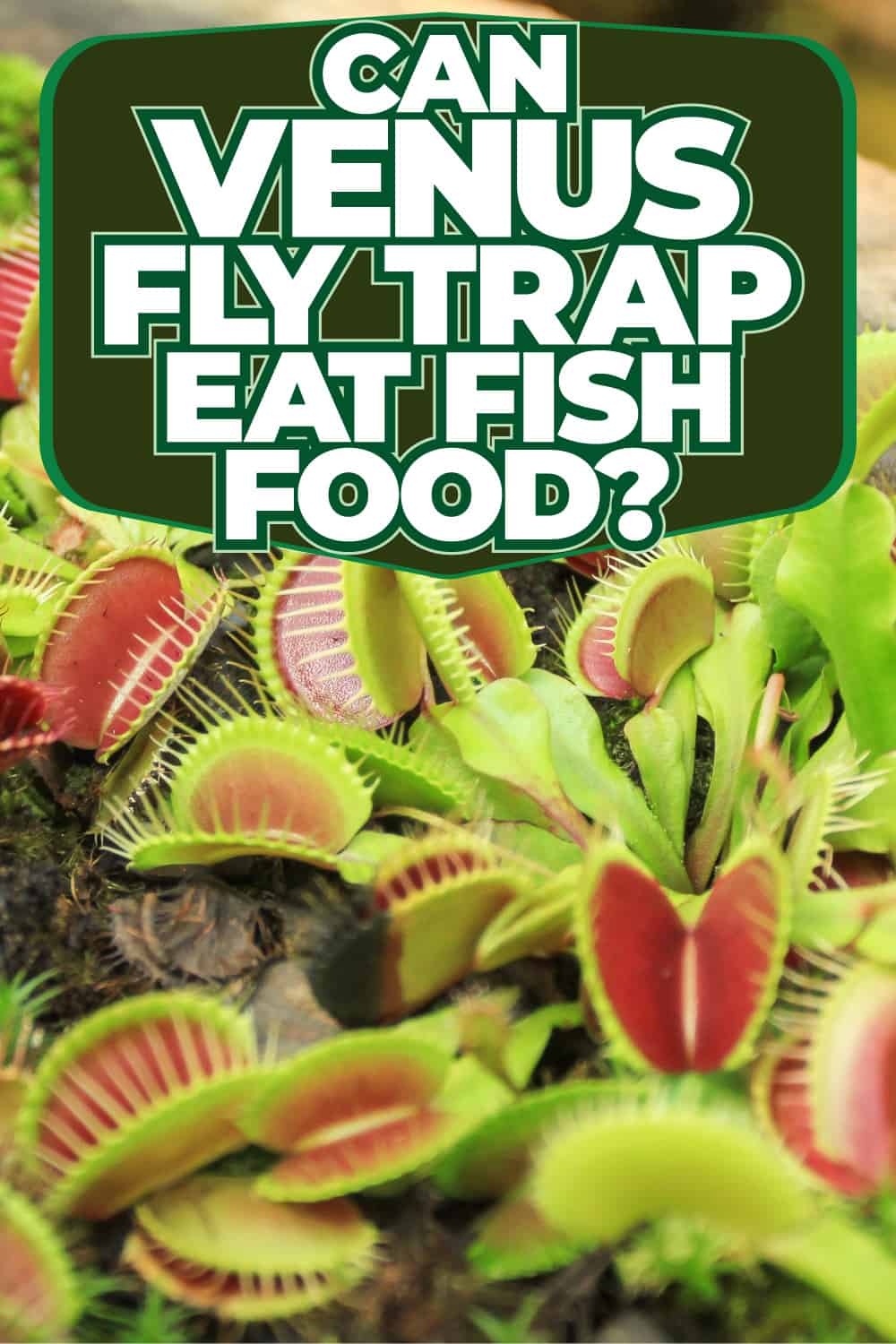Venus flytraps are popular houseplants and well-known for their unique and sometimes terrifying feeding behavior. Have you ever considered feeding your Venus fly trap fish food? Fortunately, we are here to answer that question and share our research on this plant with you.
Yes, Venus fly traps will eat wet fish food that is small enough to fit in their traps, such as fish flakes, fish or shrimp pellets, and fried dried mealworms or bloodworms.
Venus fly traps are unusual plants. Continue reading as we delve deeper into these plants. This article will also teach you how to feed these plants properly and how frequently you can do so.

What Fish Foods Can You Give To Venus Fly Traps?
Venus fly traps may consume the following fish foods:
Fish Flakes
Fish flakes are the most common type of fish food, and Venus flytraps can consume them.
Before you give the flakes to the plant, remember to water them. A small amount should be sufficient for a Venus flytrap. Tropical and cold water fish flakes are the two main types.
The main difference is that cold water flakes contain more carbohydrates and protein. However, both will suffice for Venus fly traps.
After opening, fish flakes will keep for about a month. Because Venus fly traps only eat a small amount, you may have many unused flakes. Purchasing a small package first is preferable, so you do not waste it.
Click to see Beta Fish Flakes on Amazon.
Fish Pellets
Fish pellets are a popular food source for Venus flytraps and other carnivorous plants. Just a few drops of water on top, and it's ready to eat.
Pellets can be placed in the trap with tweezers or toothpicks. Be careful not to trigger the sensors, or the trap will close unexpectedly. But don't worry, Venus flytraps are harmless.
Flakes and pellets share many similarities, but pellets may be easier to prepare for beginners. Pellets, unlike flakes, can be plucked and placed in the trap without creating a sloppy mess. This is not to say that flakes aren't good; however, you must be more patient.
Venus flytrap growers highly recommend fish pellets due to their numerous advantages. Venus flytraps and other carnivorous plants can grow faster and stronger with proper feeding pellets.
Click to see Fish Pellets on Amazon.
Shrimp Pellets Or Granules
Shrimp pellets are another excellent choice for feeding Venus flytraps. They have a similar nutritional profile to fish flakes, but because they are smaller in size, they may be easier for the plant to digest.
Before feeding shrimp pellets to your Venus flytrap, rinse and soak them thoroughly. This aids in the removal of any extra additives or residue.
Click to see this Shrimp Granules on Amazon.
Fried Dried Mealworms
These small freeze-dried mealworms are a nutritious food source for Venus flytraps and are available at many pet stores and reptile specialty stores. They come in small tubs that contain enough food to feed dozens of plants for many years.
Mealworms can be too large for fly trap seedlings at times, so for smaller plants, you may need to cut a worm into a suitable size.
Simply rehydrate the worm with a couple of drops of water, absorb any excess water with kitchen paper, and place it in the trap. Gently stroke the trigger hairs with your tweezer or chopstick.
Click to see Dried Mealworms on Amazon.
Fried Dried Bloodworms
Freeze-dried bloodworms are just another alternative for feeding Venus flytraps. These can be used to mimic the insect prey that the plant would consume in its natural habitat.
Simply soak the bloodworms thoroughly before feeding them, as they may contain additives that may harm the plant.


Click to see Dried Bloodworms on Amazon.
What Are The Advantages Of Providing Venus Fly Traps Fish Food?

Fish food has a variety of beneficial effects on Venus fly traps.
Ease of Access
Insects may be scarce or difficult to obtain in some areas. Fish food can be an easy way to supplement their diet and ensure they get enough nutrients.
Variety
Including fish food in their food can also provide various textures and taste experiences for the plant, stimulating their senses and keeping them active in their hunt for prey.
Nutrition Value
Venus fly traps benefit from protein and other essential nutrients found in fish food. This can help them stay strong and healthy, encouraging vibrant growth and trap development.
How Should You Feed Your Venus Fly Traps?

The following are the steps for properly feeding your Venus fly trap:
Step 1-Prepare The Food
You must rehydrate the Venus fly trap's food before feeding it. Hydrate it with a few drops of water. There is no need to hydrate a dead bug that you caught or discovered.
For easier handling, you could cut the insect into smaller pieces. Hydrate mealworms by breaking them up into smaller pieces. It is much easier to choose the appropriate amount for a single trap.
Step 2-Select An Appropriate Amount
You must now select the proper amount of food to feed a Venus flytrap. When it comes to bugs, a good rule of thumb is to choose an insect that is no larger than the size of the trap.
A smaller amount is preferable when feeding a dead bug, especially one purchased from a pet store. Aim for a quantity that is roughly 1/4 the size of the trap.
Larger traps are generally much easier to fit. When feeding young Venus flytraps, selecting a small enough portion can be difficult. In that case, you should think about cutting the bug into tiny pieces.
Step 3-Put The Food In The Trap.
Pick it up with your hands or a tool once you've determined the appropriate quantity. You can use chopsticks or a tweezer to do this.

Insert the feed into the trap. Ensure the entire meal fits inside the trap by aiming for the center. Always choose a smaller food.
Step 4-Trigger The Leaf Closing Mechanism
When you place the bug inside the trap, it immediately activates the lobes' closing mechanism. Other times, you may need to activate the trapping mechanism manually.
Gently touch the trigger hairs inside the trap with a chopstick or tweezers. To close the trap, you must touch them twice within a few seconds.
Step 5-Stimulate The Plant
The trap will close after you activate the trigger hairs. But it won't happen right away. It will first enter a semi-closed state.
This is perfectly normal. At this point, the plant determines whether it has captured live prey. Because it did not, we must trick the plant into starting the digestion process.
Massage the trap's sides with your finger or another small tool. Tap the trap on both sides for a minute or two until it is completely closed. Once closed, continue tapping the trap's sides to ensure digestion has begun.
Step 6-Examine The Plant
You are now finished. Observe the trap for the next few hours. It should stay nearby for several days, if not weeks while digesting the prey. If the leaf begins to turn black, the feed is probably too large for the trap.
Choose a smaller portion for your plant next time.
How Frequently Should Your Venus Fly Trap Be Fed?

Plants should be fed every 2 to 6 weeks. It takes a long time for a Venus flytrap to digest a single insect. As a result, they do not require as much feeding.
Only feed one trap on the entire plant. One bug's nutrients will suffice for the plant. Allow the plant to rest in between feedings to avoid overfeeding.
Before feeding it again, wait until the plant has thoroughly digested the previous bug. When the plant goes into dormancy, stop feeding it.
How Long Do Venus Fly Traps Live?

Venus flytraps typically live for about 20 years. As a result, they are perennial plants. It takes 4 to 6 years for a seedling to mature into a fully mature plant.
Experts in greenhouses can grow a mature plant in 2 to 3 years. After reaching maturity, Venus flytraps bloom once a year in the spring.
The plant goes into dormancy in the winter at temperatures ranging from 35 to 50 degrees Fahrenheit, which lasts until spring arrives. The plant does not grow during the dormancy period, and its metabolism slows to a crawl.
Conclusion
If you get tired of feeding your Venus flytrap bugs, try giving them fish food, which is safe for your plant to eat.
They are easier to find and less cluttered. If you feed your plants small amounts of fish food, your flytraps will have no trouble digesting them.
If you enjoyed reading this topic, you might like these other articles:
How To Harvest Venus Flytrap Seeds [Top Tips For Collection And Propagation]?
How Much Does Venus Flytrap Cost, And Where Can I Buy One?





